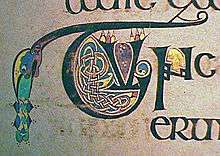Zoomorphism
"Zoomorph" redirects here. For the toy line, see Zoomorphs.

Zoomorphic text
The word zoomorphism derives from the Greek ζωον (zōon), meaning "animal", and μορφη (morphē), meaning "shape" or "form". It can mean:
- Art that imagines humans as non-human animals[1]
- Art that portrays one species of animal like another species of animal
- Art that creates patterns using animal imagery, or animal style
- Deities depicted in animal form, such as exist in ancient Egyptian religion[2]
- Therianthropy: the ability to shapeshift into animal form[3]
- Attributing animal form or other animal characteristics to anything other than an animal; similar to but broader than anthropomorphism
- The tendency of viewing human behaviour in terms of the behaviour of animals, contrary to anthropomorphism, which views animal or non-animal behaviour in human terms
Examples
Zoomorphic representation in religion
- The appearance of the Holy Spirit like a dove in the New Testament (The Gospel According to Luke 3: 22), "and the Holy Spirit descended on him in bodily form like a dove..."
But this does not portray anything exactly like zoomorphism. Holy Spirit is seen like a dove and He is not a dove. The Holy Spirit was seen (seemed to them) like a dove.
Bible does not teach zoomorphic appearance of God.
- Mark the Evangelist as a lion in later Christian iconography.
- The Egyptian gods were often depicted as zoomorphic or as hybrid
Zoomorphic language for things, ideas
- A literary phrase such as "The roar of the ocean".
- Sin lurking like a beast waiting to devour Cain in Genesis.[4]
Other
- Fenrisulfr, a wolf in Norse mythology
- Airavata, the king god of elephants in Indian mythology.
- Clawfoot bathtub, with feet in the shape of a lion's paws
- The sphinx from the "Oedipus the King" by Sophocles
- Elephantine Colossus, a hotel
- Equestropomorphism, animating objects that take the actions of a horse. For instance, in Bedknobs and Broomsticks, the army that fights the Nazis is composed of anthropomorphized knightly body armor and equestropomorphized horse armor.
- In The Flintstones and Night at the Museum, the dinosaurs Dino and "Rexy" behave and vocalize like dogs.
- Aslan in The Lion, the Witch and the Wardrobe is a lion that is the king of Narnia
- Robotic pets, like AIBO, modeled on dogs or other animals
- In 2010 city planners from Southern Sudan, which would become independent a year later, unveiled plans for the city center of its capital, Juba, to be built in the shape of a rhinoceros. The city of Wau was to be transformed in the shape of a giraffe.[5]
References
| Wikimedia Commons has media related to Animal-shaped objects. |
- ↑ Hope B. Werness, The Continuum Encyclopedia of Animal Symbolism in Art, Continuum International Publishing Group, 2004, px. ISBN 0-8264-1525-3
- ↑ Simson R Najovits, Egypt, Trunk of the Tree: A Modern Survey of an Ancient Land, Algora Publishing, 2004, p 279. ISBN 0-87586-201-2
- ↑ Gerina Dunwich, Wicca A to Z: A Modern Witch's Encyclopedia, Kensington Pub Corp, 1998, p 155. ISBN 0-8065-1930-4
- ↑ Synthesis: bulletin du Comité national de littérature comparée / Comitetul Național pentru Literatură Comparată, Institutul de Istorie și Teorie Literară "G. Călinescu." - 2002 "Sin is personified as (an animal?) which "crouches" at the door of Cain (Gen 4:7). As Gerhard von Rad (Genesis, 105) remarks, 'The comparison of sin with a beast of prey lying before the door is strange, as is the purely decorative use "
- ↑ Howden, Daniel (2010-08-19). "Turn left at the horn: 'Rhino City' revealed - Daniel Howden, ''9 August 2010''. The Independent". Independent.co.uk. Retrieved 2014-03-14.
This article is issued from Wikipedia - version of the 9/28/2016. The text is available under the Creative Commons Attribution/Share Alike but additional terms may apply for the media files.
